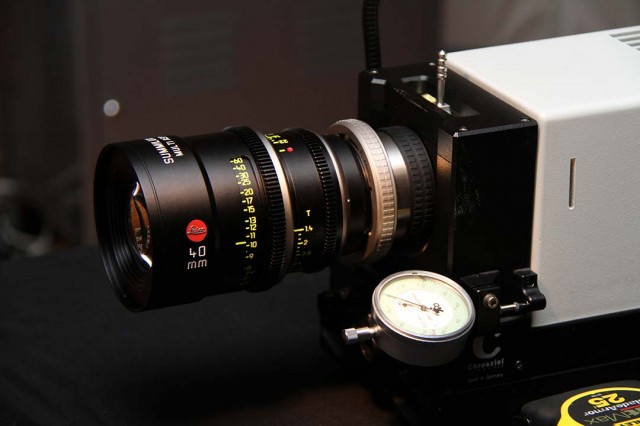One of the first demo sets of five Leica Summilux-C Prime lenses made their debut in New York at Band Pro and TCS for preliminary testing and tire-kicking. When the first complete sets arrive, they will be in rental at Otto Nemenz and available at Band Pro.
We looked at the 21, 35, 40, 50 and 75mm T1.4 Leica primes on a Chrosziel lens projector. As predicted and promised, all lenses are incredibly sharp at all apertures from the center of the test target all the way out to the edges (full 35mm aperture and beyond). Contrast is very high—rich blacks, white whites, no color fringing, no hazy internal barrel flare. There is almost no breathing. No distortion—straight lines are straight. There’s minimal shading. Shading is the “vignetting” effect, especially on wide lenses, of decreasing brightness toward the edges. In other words, if you’re shooting a big, blue sky in Montana, the entire frame will be uniformly blue. You won’t see the sky darkening as you look toward the edges.
Of course, all this optical excellence was to be expected. When these lenses were first announced as Mystery Lenses a year ago, these were the announced specifications. When word leaked out that Iain Neil was the designer and Leica was the manufacturer, the only mystery was when.
Mechanically, the lenses handle like a…well…like a Leica. The focus barrel and iris barrels are silky smooth. Camera assistants will appreciate the expanded and identical focus marks from 6’ to infinity on all the lenses. They will also appreciate that the front diameters are all 95 mm, and of course, the focus and iris gears are all in the same position. The Leica Primes are beautifully balanced: light, small and very ergonomic. Camera operators and 3D stereographers will like the small size and light weight. They are all 3.5 to 4 pounds.
Counting line pairs and obsessing over MTF charts can sound impressive, but most of us cinematographers really want to ask, “what do these lenses look like?”
So Seth Emmons, Jim Hegadorn, Jeff Cree, and I took the Leica Primes and an FGV PL Canon 7D onto the frigid streets of New York. The lenses held up better than we did. The cold had absolutely no effect on the lenses. The focus and iris barrels remained as smooth as they handled indoors. The light weight and practical size made for quick lens changes even with bulky gloves. Although the lenses could have stayed out all night on one of New York’s most frigid nights, we decided it was time for our shivering bodies to seek shelter indoors under the guise of testing a dimly lit night interior.
What does it look like? It’s a classical, magical look: Beautiful, rich blacks, no internal barrel flare, gorgeous highlights, superb lens coating that minimizes flare of lights and headlights in the shot, luminous bokehs, golden interiors. As other colleagues test them, and we do more tests, I’m sure more adjectives will be added to the vocabulary.
The first 6 shots, below, of NY night EXT and NY restaurant INT framegrabs were shot with the FGV-PL 7D and Leica Summilux-C Primes.The next 9 images of behind-the-scenes looks at Leicas were shot with a standard Canon 7D with 28-200 mm Canon zoom.
The attached framegrabs from the FGV-PL 7D were shot at 125o ISO, 1/60th second, with the 21 and 75 mm Leica primes, all wide open at T1.4. The restaurant interiors are shot handheld. The attached images are low-rez jpegs. We’ll post hi-rez originals shortly. The exteriors were stabilized with a tiny Manfrotto Gitzo Traveler tripod.









